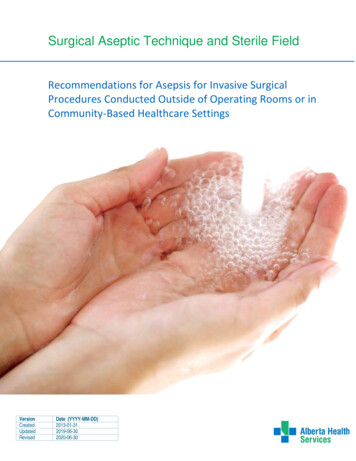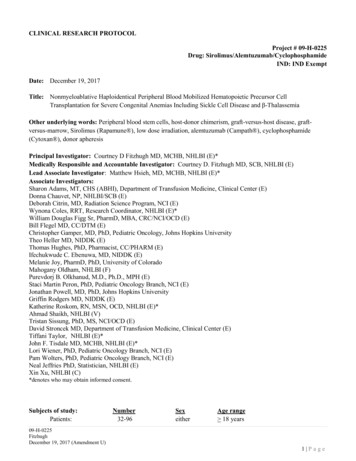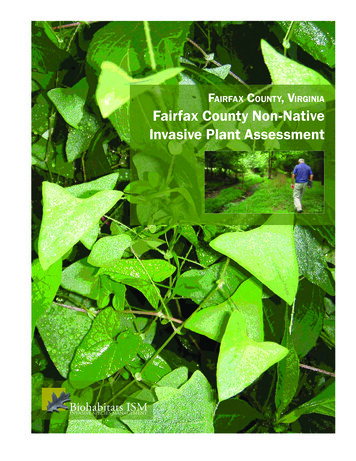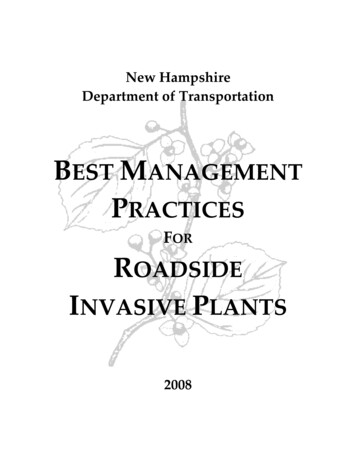
Transcription
Surgical Aseptic Technique and Sterile FieldRecommendations for Asepsis for Invasive SurgicalProcedures Conducted Outside of Operating Rooms or inCommunity-Based Healthcare SettingsVersionCreatedUpdatedRevisedDate (YYYY-MM-DD)2013-01-312019-06-302020-06-30
SURGICAL ASEPTIC TECHNIQUE AND STERILE FIELD 1Alberta Health Services Public Health and Infection Prevention and Control jointly updated these recommendationswhich replaces the 2013 version Surgical Aseptic Technique and Sterile Field: Guideline for asepsis for invasivesurgical procedures conducted in Community-based Health Care Settings.The surgical aseptic technique and sterile field recommendations provide information, support and evidence-basedpractices to health care professionals performing invasive surgical procedures outside of operating rooms or incommunity-based health care settings, such as dental clinics, podiatry clinics and medical clinics. Infectionprevention and control is a continually evolving discipline which is based on research and evidence-based practice.Note: If specific program protocols vary from the general recommendations provided in these recommendation,refer to, and follow department specific recommendations.Not Acceptable / Not SterileLegend:VersionCreatedUpdatedRevisedDate le / Sterile
SURGICAL ASEPTIC TECHNIQUE AND STERILE FIELD 2TABLE OF CONTENTSSURGICAL HAND ANTISEPSIS . 1GENERAL CONSIDERATIONS . 1SURGICAL HANDRUB . 2SURGICAL HANDSCRUB. 3HAND HYGIENE TIPS . 4GOWNING AND GLOVING . 5GENERAL CONSIDERATIONS . 5GOWNING AND CLOSED GLOVING . 5GOWNING AND OPEN GLOVING . 8STERILE FIELD . 9GENERAL CONSIDERATIONS . 9ESTABLISHING THE STERILE FIELD . 10DISPENSING STERILE SUPPLIES. 11MAINTAINING A STERILE FIELD . 12STERILE TECHNIQUE WITHOUT CIRCULATING PERSONNEL . 13DEFINITIONS . 14REFERENCES. 16VersionCreatedUpdatedRevisedDate (YYYY-MM-DD)2013-01-312019-06-302020-06-30
SURGICAL ASEPTIC TECHNIQUE AND STERILE FIELD 1SURGICAL HAND ANTISEPSIS Objective of surgical hand antisepsis is to reduce the transient andresident flora. Skin can never be rendered sterile. It can be madesurgically clean by reducing the number of organisms present withthe mechanical action associated with scrubbing. Surgical handantisepsis is only effective if all surfaces of the hand are exposedto the mechanical cleaning and chemical antisepsis. Process of removing as many microorganisms as possible from thehands and forearms by mechanical washing and chemicalantisepsis before participating in a surgical procedure. Performed prior to donning sterile gloves or sterile gowns and gloves for surgical or other invasiveprocedures. Achieved with either an antimicrobial surgical scrub agent (surgical hand scrub) or an alcohol basedantiseptic surgical hand rub (surgical hand rub) with documented persistent and cumulative activity.1,2 Follow manufacturer’s instructions for use for the product for surgical hand antisepsis.GENERAL CONSIDERATIONS Refer to the AHS Hand Hygiene Policy and Procedure or organization/department specific protocols forgeneral hand hygiene information, including recommendations for fingernails, e.g., clean, short, natural nails Wash hands with soap and water if hands are visibly soiled or as required by the product manufacturer’sinstruction for use. Remove all rings, wrist watches and bracelets prior to starting surgicalhand antisepsis. (Figure 1) Don hair covers, protective eyewear and surgical mask prior to initiatingthe surgical hand antisepsis. (Figure 2) Keep hands above the level of the elbow so that water flows downduring the surgical hand scrub and rinsing process. Avoid contact with the faucet or other potentialcontaminants. (Figure 3) Dry hands thoroughly using a sterile towel following a surgical hand scrub. Thorough drying is essential asmoist surfaces allow pathogens to multiply.12VersionCreatedUpdatedRevisedDate (YYYY-MM-DD)2013-01-312019-06-302020-06-303
SURGICAL ASEPTIC TECHNIQUE AND STERILE FIELD 2SURGICAL datedRevisedDate (YYYY-MM-DD)2013-01-312019-06-302020-06-30
SURGICAL ASEPTIC TECHNIQUE AND STERILE FIELD 3SURGICAL HANDSCRUB1. Remove hand and arm jewelry including rings, watches and bracelets.2. With clean hands don hair cover, surgical mask and eye protection.3. Perform surgical handscrub.a. Clean under the nail (subungual areas) of both hands under running water using a disposable nailcleaner.b. Rinse hands and forearms under running water.4. Use an approved scrub solution according to the manufacturer’s written instructions.a. Apply the scrub solution to wet hands and forearms. Sponges, if used, are soft and non-abrasive.VersionCreatedUpdatedRevisedDate (YYYY-MM-DD)2013-01-312019-06-302020-06-30
SURGICAL ASEPTIC TECHNIQUE AND STERILE FIELD 4b. Time the application of the scrub solution according to the manufacturer’s written directions to allowadequate product contact with skin.c. For each hand visualize each finger, thumb, hand and arm as having four sides. Wash all four sideseffectively, keeping the hands elevated.d. Avoid splashing surgical attire.e. Discard used sponges.f. Rinse hands and arms under running water in one direction from the fingertips to elbows as often asneeded to remove soap. Take care to ensure fingers, hands and arms do not touch the faucet andthe hands remain above the level of the elbows. If the water is controlled with hand control leversthen the water is turned off by circulating personnel.g. Ensure hands are held away from the body with hands and forearms held higher to preventcontamination by allowing the water to run from the clean to less clean area. Keep the surgical attiredry as the sterile gown cannot be donned over wet or damp attire without potential contaminationof the gown by strike-through moisture.h. Dry hands with a sterile towel.5. Don sterile gown and gloves.1HAND HYGIENE TIPS1. Keep nails natural, clean, short and healthy3.2. Adhere to facility or organization policies on use of nail polish. Refer to the AHS Hand Hygiene Policy andProcedure or organization/department specific protocols for general hand hygiene information.3. Do not wear artificial nails or nail enhancements.4. Remove all hand and arm jewellery for invasive surgical procedures.5. Do not scrub if you have cuts, abrasions, weeping dermatitis or fresh tattoos on exposed skin.VersionCreatedUpdatedRevisedDate (YYYY-MM-DD)2013-01-312019-06-302020-06-30
SURGICAL ASEPTIC TECHNIQUE AND STERILE FIELD 5GOWNING AND GLOVING Following completion of the surgical hand antisepsis, it is importantto correctly don a sterile surgical gown and sterile gloves. Gowns are only considered sterile in the front from the axilla(armpit) to the level of the sterile field and sleeves from 5cm(2inches) above the elbow to cuff. The neckline, shoulders, underarms, sleeve cuffs and the back are considered unsterile4. (Figure 4)GENERAL CONSIDERATIONS4 Gowns are donned before gloves. The scrubbed personnel gowns and gloves from a separate table or surface that is waist height, away fromthe main sterile field (to avoid any chance of contaminating the sterile field) using the “closed gloving”technique. The scrubbed personnel gowns and gloves the dentist/surgeon (and other sterile team members) using theassisted “open gloving” technique. Sterile gowns are:a. Made of a material that is resistant to penetration of blood and other fluids.b. Folded to allow the gown to remain sterile during donning and large enough to adequately cover thescrubbed personnel.c. Gown cuffs are considered unsterile and are to be covered by sterile gloves because they:i. tend to collect moisture,ii. are not an effective barrier and,iii. become contaminated when the scrubbed person’s hands pass through the cuff.1GOWNING AND CLOSED GLOVING1. Reach and lift the folded gown directly upward. Do not touch the wrapper and ensurethe gown remains folded until after stepping back from the gown table into anunobstructed area. (Figure 5)2. Holding the folded gown like a book by its binding, carefully locate the neckline andarmholes. (Figure 6)65VersionCreatedUpdatedRevisedDate (YYYY-MM-DD)2013-01-312019-06-302020-06-30
SURGICAL ASEPTIC TECHNIQUE AND STERILE FIELD 63. Hold the inside front of the gown just at the armholes with both hands,let the gown unfold, keeping the inside of the gown toward the body andthe hands in the armholes. Do not touch the outside of the gown withbare hands. If the top of the gown drops inadvertently, consider itcontaminated. Discard and have a new gown pack opened. (Figure 7)4. Extend both arms into the armholes simultaneously as the gown and itssleeves unfold.75. The circulating personnel, stands behind the scrubbed personnel and brings the gown over the shoulders byreaching inside to the shoulder and arm seams. (Figure 8) The gown is pulled on, leaving the cuffs of the sleevesextended over the hands. Do not push the hands through the cuffs. The back of the gown is securely tiedat the waist first, followed by the neckline. (Figure 9) If the gown is a wrap-around style, the sterile flap to coverthe back is not touched until the scrubbed personnel has donned gloves or by use of a sterile item handedto circulating personnel.986. Using gown cuff covered hands take the sterile gloves from the circulatingpersonnel. Do not touch the external wrapper of the gloves when taking thegloves out of the wrapper and keep hands inside the cuff at all times duringthe gowning and gloving procedure. (Figure 10)7. Using gown cuff covered hands place the gloves in the paper wrapper on thesurface that held the gown. Place the glove paper in front of you like a book.Open the two sides like a book by grasping the lower inner corners of thebottom fold. Lift both corners open and fold under at the same time to keepthe wrapper open and prevent it from falling closed during the glovingprocess. (Figure 11)10118. Extend the dominant forearm with the palm upward.9. With the covered non-dominant hand, pick up the glove for the dominanthand from the inner wrap of the glove package by grasping the glove cuff,lifting straight up, place it on the dominant palm thumb side down. The glove fingers will be pointing towardthe body. (Figure 12)12VersionCreatedUpdatedRevisedDate (YYYY-MM-DD)2013-01-312019-06-302020-06-30
SURGICAL ASEPTIC TECHNIQUE AND STERILE FIELD 710. Grasp the upper glove cuff with the cuffed non-dominant hand while holdingthe underside of the cuff with the cuffed dominant hand. Peel the cuff of theglove over the dominant cuffed hand, over the end of the sleeve. Hold thesleeve and glove cuff with the non-dominant hand and pull back the sleevewhile wiggling the fingers of the dominant hand to extend them into the glove.The glove covers the entire gown cuff. (Figure 13)11. Using the gloved hand, pick up the remaining glove and place it with the palmof the glove against the palm of the non-dominant hand. Grasp the back of thecuff of the glove above the palm in the gloved hand and turned over the sleeveand hand. (Figure 14)1312. The cuff of the glove is now over the gown cuff of the sleeve with the hand stillin the sleeve.13. Grasp the top of the glove and underlying gown sleeve with the gloved handand pull the sleeve allowing the glove to be pulled onto the non-dominant hand.(Figure 15)1414. Grasp the tie and protector. Remove one tie from the protector. Hand theprotector to the circulating personnel. Turn to wrap the back panel of the gownaround the scrubbed personnel, covering the previously tied inner waist ties.Carefully pull the tie out of the protector held by the circulating personnel andtie to secure the gown. (Figure 16-18) The ties are not dropped below waist levelbefore it is tied. If ties drop the circulating personnel ties the gown at the back.51516VersionCreatedUpdatedRevised17Date (YYYY-MM-DD)2013-01-312019-06-302020-06-3018
SURGICAL ASEPTIC TECHNIQUE AND STERILE FIELD 8GOWNING AND OPEN GLOVING1. Sterile gowns for each member of the team are handed to the scrubbed personnel in a manner whichmaintains sterility. The gown is then placed on the sterile field.2. The scrubbed personnel picks up the gown and holds it away from the sterile field and allowing it to unfoldwith the inside of the gown held toward the individual being assisted with gowning and gloving. (Figure 19) Thescrubbed personnel protects their gloved hands by1920holding the gown with a cuff over the glove andallows the individual being assisted to reach intothe sleeves of the held gown. (Figure 20) Thecirculating personnel reaches to grasp the inside ofthe gown and carefully bring it up and over theshoulders being sure not to touch the outside ofthe front of the gown. The inside ties of the gownat the neck and waist are tied by the circulating personnel. The individual being gowned allows their handsto extend beyond the cuffs of the gown and ensure their hands remain above waist level not touching thegown.3. Once the gown is on, the scrubbed personnel picks up the right glove and holds it with the cuff (to protectthe gloved hands from touching the bare hand of the individual being assisted with gowning and gloving).The palm of the glove is turned toward the ungloved individual’s hand with the glove21directly opposed to the thumb of the individual’s hand. Using fingers stretch the cuffto open the glove. (Figure 21) The individual being assisted with gloving will place their handin the glove and the cuff will extend up the sleeve to cover the stockinette of the sleeve.(Figure 22)4. The scrubbed personnel repeats this process. With the second glove the individualbeing assisted can help to open the glove by placing the gloved hand under the cuff ofthe glove to increase the opening while inserting the ungloved hand. Again the cuff willbe pulled up to cover the entire stockinette cuff of the sleeve.5. Once gloving is completed the wrap around tie can be handed to the scrubbedpersonnel to allow the gown to be closed5. (Figure 23-24)23VersionCreatedUpdatedRevisedDate (YYYY-MM-DD)2013-01-312019-06-302020-06-302422
SURGICAL ASEPTIC TECHNIQUE AND STERILE FIELD 9STERILE FIELDGENERAL CONSIDERATIONS1. Only sterile items are used within the sterile field.a. Prior to items being dispensed to the sterile field check the external and internal chemical indicators onand in the package, check for package integrity, and package expiration (if appropriate).2. Items which display a manufacturer’s expiry date are considered unsafe for use after that date. (Rationale:Expiry dates do not guarantee either sterility or lack of sterility1. Frequently expiry dates refer to thedegradation of the product or a component of the product after the specified date.)3. If in doubt about the sterility of the packaged item, it is not considered sterile. This includes:a. items found in unmonitored areas,b. any indication of the package being wet (e.g., water stains, dampness or condensation in package),c. any package without chemical indicator (CI) showing a “pass” result,d. any package that has been dropped or,e. any package that shows evidence of crushing, perforations or holes.4. Whenever a sterile item has been compromised, the package contents, gown or the sterile field involvedare considered contaminated. This may happen when:a. non sterile items contact sterile items;b. liquids or moisture soak through a drape, gown, or package (strikethrough).5. Single-use medical devices are used on an individual client for a single procedure and then are discarded6.6. Reusable medical devices are reprocessed according to the manufacturer’s directions for use and inaccordance with current Alberta Health Standards7.7. Refer to IPC recommendations on Storage of Clean and Sterile Supplies in Clinical Areas for details onstorage and handling sterile supplies such as temperature and humidity requirements.VersionCreatedUpdatedRevisedDate (YYYY-MM-DD)2013-01-312019-06-302020-06-30
SURGICAL ASEPTIC TECHNIQUE AND STERILE FIELD 10ESTABLISHING THE STERILE FIELD1. Use sterile drapes to cover surfaces or operative fields and provide a barrier against micro-organisms,liquids, and particulate matter2.2. Surgical drapes are only sterile at table level.a. The drape below the working surface is not under direct vision of the surgical team and is notconsidered sterile. The edges of the table top serve as ademarcation line between sterile and non-sterile.b. Any item that falls below the table level is consideredunsterile. This applies to the edges of the drape andportion of suction and irrigation tubing that is handed offthe sterile field.3. If the drape does not cover the entire surface, a 1-inch marginaround the edge of the drape is considered unsterile. (Figure 25)4. The edges of packages are considered unsterile. When opening25packages for a sterile procedure prevent the wrapper from touching the sterile field or package contents.a. Control all flaps of non-woven wrap to prevent them from touching the sterile field. (Figure 26)b. The sterile boundary of a peel-open package is the inner edge. Peel pouches are peeled back not rippedor torn when opening. Do not push devices through the peel pouch. The inner edge of the seal is thedemarcation for sterile and non-sterile. (Figure 27)c. Do not flip or drop items onto the sterile field. (Figure 28)2627285. Clean and dry flat surfaces before placing a sterile bundle or drape on them. (Rationale: moisture may causestrike-through and contaminate the sterile field. Dust may become airborne and land on the sterile field.)VersionCreatedUpdatedRevisedDate (YYYY-MM-DD)2013-01-312019-06-302020-06-30
SURGICAL ASEPTIC TECHNIQUE AND STERILE FIELD 11DISPENSING STERILE SUPPLIES1. Open supplies as close to possible to the surgical start time. (Rationale: the potential for contaminationincreases with time and particles stirred up by movement of personnel which can settle on horizontalsurfaces.5)2. Handle sterile supplies as little as possible. (Rationale: increased handling increases the potential forcontamination and prolongs set-up time.)3. Assess all items added to sterile field prior to opening for sterility by checking package integrity, and chemicalindicators for a “pass” result.4. Open large bundles or packages on a flat surface. (Rationale: large and/or heavy items are difficult to openaseptically while being held in the circulating personnel’s hand.)5. Maintain sterility and integrity of items introduced onto a sterile field as they are opened, dispensed, andtransferred1.6. Methods of transfer include, but are not limited to the following:a. Place the item on the edge of the sterile instrument table with the inside of thewrapper covering your hand. Never reach over a sterile field and shake an itemfrom its package.b. Expose the contents so the scrubbed personnel can remove the item from thewrapper or package using a forcep or by grasping the item. (Figure 29)29c. Do not flip items onto the sterile field. (Rationale: flipping creates air turbulence. It also creates thepotential for contamination or damage.5).7. Pour sterile solutions into a sterile receptacle. The scrubbed personnel holds the receptacle away from thetable or places it on the edge of the draped surface eliminating the need for the circulating personnel toreach across the sterile field. (Figure 30, 31)30318. Discard any remaining solution once the contents (sterile solution) of the bottle have been dispensed intothe sterile receptacle. (Rationale: re-application of caps is a questionable technique as the pour spout andcap may have been contaminated. The edge of a container is considered contaminated after the contentshave been poured; therefore, the sterility of the contents cannot be ensured if the cap is replaced.1 )9. Discard or dismantle supplies that have been opened once a patient has entered the operatory in the eventthe procedure is cancelled or if they are not used. (Rationale: potential for cross-contamination will beprevented).VersionCreatedUpdatedRevisedDate (YYYY-MM-DD)2013-01-312019-06-302020-06-30
SURGICAL ASEPTIC TECHNIQUE AND STERILE FIELD 12MAINTAINING A STERILE FIELD1. Circulating personnel do not touch or reach over sterile items or areas.(Rationale: invisible shedding of skin laden with micro-organisms maycontaminate sterile items or areas.) (Figure 32)2. Scrubbed personnel do not touch or reach over unsterile items or areas.(Rationale: contamination of sterile gown or gloves may occur.)3. When a scrubbed personnel opens a sterile table cover or drape it isopened first toward the sterile individual. This minimizes the chance ofthe scrubbed personnel becoming contaminated by contacting a nonsterile surface. (Figure 33)4. If the circulating personnel opens a sterile pack, the wrap is opened firstaway from the circulating personnel to prevent contamination of thepack. (Figure 34)32335. Ensure movement within the sterile field does not contaminate the field.Sterile personnel stay close to the sterile field. If sterile personnel changepositions during the procedure they can move face to face or back toback. They never turn their back on the sterile field. 86. Do not leave open/set-up sterile supplies unattended and monitor themcontinuously for possible contamination. (Rationale: sterility ofunattended items cannot be ensured without direct observation. Eventrelated sources of possible contamination can occur at any time.)347. Do not cover the sterile set-up. (Rationale: removing a table cover without contaminating the sterile areacannot be achieved. The drape below the level of the tabletop is considered contaminated, and the coverwould touch the table top during removal.4,5 )VersionCreatedUpdatedRevisedDate (YYYY-MM-DD)2013-01-312019-06-302020-06-30
SURGICAL ASEPTIC TECHNIQUE AND STERILE FIELD 13STERILE TECHNIQUE WITHOUT CIRCULATING PERSONNELThis section outlines basic sterile technique when performing a minor invasive procedure outside of operatingrooms or in community based health care settings without the assistance of circulating (non-scrubbed) personnel,e.g., surgical removal of ingrown toenails, joint injections. It was adapted from Lippincott Procedures. 2018.Sterile Technique, Basic.1. Follow routine practices including hand hygiene.2. Prepare a sterile field and then, using aseptic non-touch technique, set up the necessary supplies on thesterile field. See page 16 for information on dispensing sterile supplies.3. Don a cap and mask.4. Perform hand hygiene.5. Don a gown and gloves.6. If there is an existing dressing to be removed, gently remove the dressings and discard carefully in animpervious plastic garbage bag.7. Doff your gown and gloves.8. Perform hand hygiene.9. Don a sterile gown and sterile gloves. You will need a second person to tie the waist and neck of thesterile gown. See page 7 for information on gowning and closed gloving.10. Perform procedure.11. Dispose of all equipment in appropriate receptacles.12. Doff and discard your gloves and other personal protective equipment.13. Perform hand hygiene.VersionCreatedUpdatedRevisedDate (YYYY-MM-DD)2013-01-312019-06-302020-06-30
SURGICAL ASEPTIC TECHNIQUE AND STERILE FIELD 14DEFINITIONSAseptic non-touch technique means maintaining asepsis by not touching sterile equipment or areas with the intentof reducing the risk of transmission of infection to patients.Circulating (non-scrubbed) personnel means staff that work in the periphery of the sterile field. Circulatingpersonnel wear non-sterile scrubs and cover wear to perform duties such as delivering equipment and supplies tothe surgical staff, documentation, and specimen handling.Closed gloving technique means a gloving technique in which the hands are not extended from the sleeves and cuffswhen the gown is put on. Instead the hands are pushed through the cuff openings as the gloves are pulled intoplace.Doff means to take off (an article of clothing or wear).Don means to put on (an article of clothing or wear).Open gloving technique means a gloving technique in which the scrubbed person’s hands slide all the way throughthe sleeves and cuffs when the gown is put on prior to donning gloves.Product for surgical hand antisepsis means product used for surgical hand preparation with the followingcharacteristics: 1) significantly reduces microorganisms on intact skin, 2) contains a non-irritating antimicrobialpreparation with broad spectrum activity and 3) fast acting and persistent. The most commonly used soaps forsurgical hand washing contain chlorhexidine or povidone-iodine. Alcohol based products for surgical hand rubsfrequently have additional long acting compounds such as chlorhexidine gluconate or quaternary ammoniumcompounds.Scrub (scrubbed) personnel means staff who work directly in the surgical field. Scrub personnel perform surgicalhand antisepsis before donning a sterile gown and gloves. Duties may include establishing and maintaining thesurgical field, assisting the surgical team by donning sterile masks, gloves and gowns and passing instrumentsduring surgery.Sterile field means the area around the site of incision into tissue or site of introduction of an instrument into anorifice that has been prepared for the use of sterile supplies and/or equipment.Strike-through means an event whereby sterile drapes or packages become contaminated due to soaking throughor forcing through of moisture or air.VersionCreatedUpdatedRevisedDate (YYYY-MM-DD)2013-01-312019-06-302020-06-30
SURGICAL ASEPTIC TECHNIQUE AND STERILE FIELD 15Surgical aseptic technique means “sterile technique” used for invasive procedures including minor surgicalprocedures that may be performed in community health care setting such as cataract removal; biopsies;laparoscopy; hernia repair, dental implants and foot surgery. The goal of surgical aseptic technique is to maintainthe microbial count to an irreducible minimum using sterile medical device; practices such as surgical hand scruband patient skin antisepsis; and barriers including sterile gloves, sterile gown, masks and sterile drapes to preventtransferring microorganisms for the environment to the patient during the procedure.Surgical drape means material intended for use on a sterile field that provides an adequate barrier to microbes,particulate matter and fluids; and is tear and puncture resistant; flexible; memory free; moisture repellant; lowlinting; antistatic, flame retardant and free of noxious odors.Surgical hand antisepsis means the process of removing debris and transient microorganisms from the nails, hands,and forearms; reducing the resident microbial count to a minimum; and inhibiting regrowth of microorganisms.VersionCreatedUpdatedRevisedDate (YYYY-MM-DD)2013-01-312019-06-302020-06-30
SURGICAL ASEPTIC TECHNIQUE AND STERILE FIELD 16REFERENCES1. Association of perioperative Registered Nurses. 2019. Perioperative standards and recommendedpractices. Available at: http://aornstandards.org2. Canadian Standards Association (CSA). 2018. Z314-18. Canadian Medical Device Reprocessing. Availableat: -10/invt/27030452010.3. Public Health Agency of Canada. 2012. Hand Hygiene Practices in Healthcare Settings. Available free ofcharge at: ion.html.4. Operating Room Nurses Association of Canada (ORNAC). 2017. Standards, guidelines, and positionstatements for perioperative registered nurses. Available at: http://shop.csa.ca/invt/270311220115.
community-based health care settings, such as dental clinics, podiatry clinics and medical clinics. Infection prevention and control is a continually evolving discipline which is based on research and evidence -based practice. Note: If specific program protocols vary from the general recommendations provided in these recommendation,










